What Causes Clouds to Reflect a Portion of Sunlight Back to Space
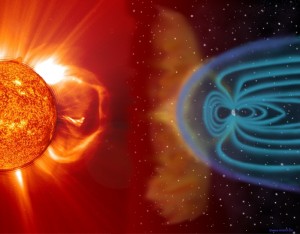
Courtesy of SOHO consortium. SOHO (Solar and Heliospheric Observatory) is a project of international cooperation betwixt the European Space Agency and NASA.
Did y'all know that the dominicus blasts more a billion tons of matter out into infinite at millions of kilometers per hour? Ultimately, energy from the dominicus is the driving strength behind weather and climate, and life on earth. But what kinds of energy come from the sun? How does that energy travel through space? And what happens when it reaches earth?
RADIANT ENERGY
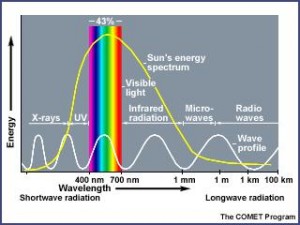
Copyright 2000-2001 University Corporation for Atmospheric Research. All Rights Reserved. Used with permission.
The sunday emits many forms of electromagnetic radiation in varying quantities. As shown in the diagram (opposite), near 43 percent of the total radiant energy emitted from the lord's day is in the visible parts of the spectrum. The majority of the remainder lies in the
near-infrared (49 percent) and ultraviolet section (vii percent). Less than ane percent of solar radiations is emitted as x-rays, gamma waves, and radio waves.
The transfer of energy from the sunday beyond nearly empty infinite (recollect that space is a vacuum) is accomplished primarily by radiation. Radiation is the transfer of free energy by electromagnetic wave move.
FIRST STOP: World'Southward Atmosphere
Once the lord's day's free energy reaches world, information technology is intercepted get-go by the temper. A small part of the sun'south energy is directly absorbed, specially by certain gases such as ozone and water vapor.
Some of the sun'southward free energy is reflected back to space by clouds and the earth's surface.
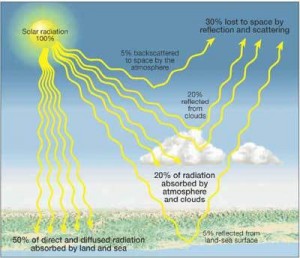
Copyright 2000-2001 University Corporation for Atmospheric Enquiry. All Rights Reserved. Used with permission.
Nigh of the radiations, however, is absorbed by the earth'due south surface. When the radiation is absorbed past a substance, the atoms in the substance move faster and the substance becomes warm to the touch. The absorbed energy is transformed into heat energy. This heat energy plays an important role in regulating the temperature of the earth's crust, surface waters, and lower atmosphere.
Every surface on earth absorbs and reflects energy at varying degrees, based on its colour and texture. Dark-colored objects absorb more visible radiation; light-colored objects reflect more visible radiation. Shiny or smooth objects reverberate more than, while dull or crude objects absorb more. Differences in reflection impact temperature, weather, and climate.
REFLECT OR Blot?
Scientists employ the term albedo to depict the per centum of solar radiation reflected back into space by an object or surface.
A perfectly black surface has an albedo of 0 (all radiation is absorbed). A perfectly white surface has an albedo of 1.0 (all radiation is reflected).
Different features of globe (such as snowfall, ice, tundra, ocean, and clouds) accept different albedos. For case, state and body of water have low albedos (typically from 0.one to 0.4) and absorb more energy than they reflect. Snow, ice, and clouds have high albedos (typically from 0.7 to 0.ix) and reflect more energy than they absorb.
Earth's average albedo is about 0.iii. In other words, well-nigh 30 pct of incoming solar radiation is reflected back into space and 70 percent is absorbed.
A sensor aboard NASA'due south Terra satellite is at present collecting detailed measurements of how much sunlight the globe's surface reflects dorsum upwards into the atmosphere. Past quantifying precisely our planet's albedo, the Moderate Resolution Imaging Spectroradiometer (MODIS) is helping scientists understand and predict how various surface features influence both short-term weather patterns as well every bit longer-term climate trends.
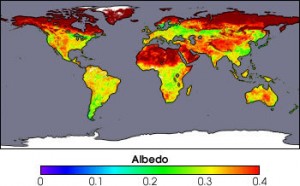
Image courtesy of NASA Earth Observatory.
The colors in this image emphasize the albedo over the world's land surfaces, ranging from 0.0 to 0.4. Areas colored red show the brightest, nigh reflective regions; yellows and greens are intermediate values; and blues and violets show relatively dark surfaces. White indicates where no information were available, and no albedo data are provided over the oceans.
Equally shown in the image, the snow- and ice-covered Arctic has a high albedo. (Though no data were available, Antarctica would too have a high albedo.) Desert areas, such as the Sahara in Northern Africa, also reflect a great deal of radiation. Forested areas or areas with night soil blot more radiation and have lower albedos.
Human and natural processes accept inverse the albedo of earth's country surfaces. For example, earth's boilerplate albedo was much higher during the last ice age than it is today. Human impacts such equally deforestation, air pollution, and the subtract in Chill sea ice have also affected albedo values. These changes modify the net amounts of energy absorbed and radiated back to space.
World'Due south RADIATION BUDGET
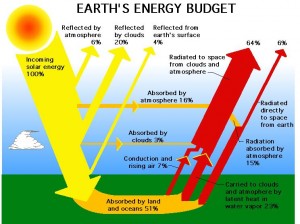
NASA Atmospheric Scientific discipline Data Centre. Used with permission.
Earth's radiations budget is a concept that helps usa empathise how much energy Globe receives from the Sun, and how much energy Earth radiates back to outer space.
Changes in the earth's crust such as glaciation, deforestation, and polar water ice melting alter the quantity and wavelength of electromagnetic absorption and reflection at the globe's surface.
Water ice, Climate change, AND THE EARTH'S ENERGY Upkeep
Ice affects the unabridged globe system in a multifariousness of means. In the ocean and at the land-sea boundary, ice prevents relatively warm ocean water from evaporating, transferring heat to the colder atmosphere and thereby increasing global air temperature.
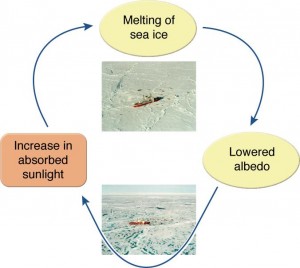
Prototype courtesy of Hugo Ahlenius, UNEP/Filigree-Arendal Maps and Graphics Library.
Ice also reflects sunlight, thus preventing additional oestrus from being absorbed by h2o or land. The water ice-covered polar regions are colder than other places on earth, due in part to the high albedo of the snow and water ice embrace.
As earth's climate warms, water ice in the form of glaciers and ocean ice has decreased dramatically. Data generated from satellites that monitor the formation of polar sea water ice bespeak that both coverage and thickness have decreased over the past 3 decades. Recent studies show that the world's highest glaciers (in the Himalayas) are receding at an average rate of 10 to fifteen meters (33 to 49 feet) per twelvemonth. A report released in June 2008 indicates that Arctic sea ice extent shrank to a record low in the summer of 2007.
The decreasing extent of ice in the polar regions (in particular, the sea ice of the Arctic) is part of a positive feedback loop that tin can accelerate climate change. Warmer temperatures melt snow and ice, which decreases globe's albedo, causing further warming and more melting.
Human activities that create pollution also influence the energy residue. For instance, when we burn coal, oil, wood, and other fuels, the carbon byproduct, soot, is released into the temper and eventually deposited back on earth. The dark particles land on snow and ice, and decrease albedo. The darkened snowfall and ice blot more radiations than pure snowfall and water ice. In add-on, every bit the snow and water ice cook, the soot embedded in the snow is left backside and becomes more full-bodied on the surface, farther accelerating warming.
IN Decision
There's no doubt almost information technology – without the sun's radiant energy, life on earth would not exist. Just as the earth warms and polar water ice declines, the balance of absorbed and reflected free energy shifts – leading to further change.
Resource
Globe'southward Albedo and Global Warming
This interactive activity adapted from NASA and the U.S. Geological Survey illustrates the concept of albedo – the mensurate of how much solar radiation is reflected from Globe's surface.
World's Cryosphere: The Arctic
This four-minute video segment adapted from NASA uses satellite imagery to provide an overview of the cryosphere (the frozen parts of the earth's surface) in the Northern Hemisphere, including the Arctic.
Earth'southward Cryosphere: Antarctica
This video segment adapted from NASA uses satellite imagery to provide an overview of the cryosphere in the Antarctic.
Chill Body of water Ice News & Assay
The National Snowfall and Water ice Data Center (NSIDC) provides the latest news, inquiry, and analysis of Arctic sea water ice.
Sea Level: Water ice Volume Changes
This resource provides a simulation of icebergs and glaciers melting and the impact melting has on sea level.
NATIONAL Scientific discipline EDUCATION STANDARDS: SCIENCE CONTENT STANDARDS
The entire National Science Education Standards document tin be read online or downloaded for free from the National Academies Press web site. The post-obit excerpt was taken from Chapter 6.
A study of energy, the sun, and albedo aligns with the Physical Scientific discipline, Globe and Space Scientific discipline, and the Science in Personal and Social Perspectives content standards of the National Science Instruction Standards:
Physical Science (Content Standard B): Grades 1000-four
As a result of their activities in grades Thousand-4, all students should develop an understanding of backdrop of objects and materials including light, heat, electricity, and magnetism.
- Objects have many appreciable backdrop, including size, weight, shape, color, temperature, and the power to react with other substances. Those properties can be measured using tools, such as rulers, balances, and thermometers.
- Light travels in a straight line until information technology strikes an object. Light can exist reflected by a mirror, refracted by a lens, or captivated by the object.
- Heat can exist produced in many ways, such as burning, rubbing, or mixing 1 substance with another. Heat can move from one object to another by conduction.
Physical Science (Content Standard B): Grades 5-8
As a effect of their activities in grades v-eight, all students should develop an agreement of world in the solar organisation.
- The sun is the major source of energy for phenomena on the world's surface, such as growth of plants, winds, ocean currents, and the water cycle.
- Seasons effect from variations in the amount of the sun's energy hitting the surface, due to the tilt of the earth'south rotation on its axis and the length of the day.
Science in Personal and Social Perspectives (Content Standard F): Grades K-4
As a result of their activities in grades K-iv, all students should develop an understanding of changes in environments.
- Environments are the space, conditions, and factors that bear on an individuals' and a populations' ability to survive and their quality of life.
- Changes in environments can be natural or influenced by humans. Some changes are practiced, some are bad, and some are neither good nor bad.
- Some environmental changes occur slowly, and others occur rapidly.
Science in Personal and Social Perspectives (Content Standard F): Grades 5-8
As a result of their activities in grades five-8, all students should develop an understanding of natural hazards.
- Human activities can induce hazards through resource acquisition, urban growth, land-use decisions, and waste material disposal. Such activities can accelerate many natural changes.
This article was written past Kimberly Lightle. For more than information, see the Contributors page. Electronic mail Kimberly Lightle, Main Investigator, with any questions about the content of this site.
Copyright October 2008 – The Ohio Land University. This material is based upon work supported by the National Science Foundation under Grant No. 0733024. Any opinions, findings, and conclusions or recommendations expressed in this material are those of the author(due south) and do not necessarily reflect the views of the National Science Foundation. This piece of work is licensed under an Attribution-ShareAlike 3.0 Unported Creative Eatables license .
Source: https://beyondpenguins.ehe.osu.edu/issue/energy-and-the-polar-environment/solar-energy-albedo-and-the-polar-regions
0 Response to "What Causes Clouds to Reflect a Portion of Sunlight Back to Space"
Post a Comment